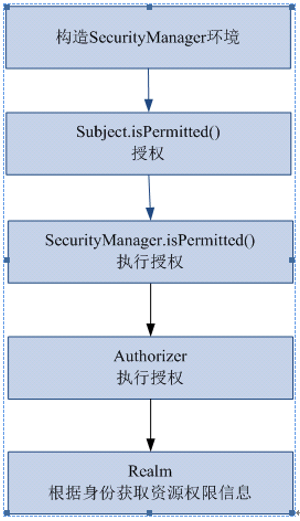006-shiro授权
一、授权流程

二、三种授权方式
2.1、编程式:通过写if/else 授权代码块完成:
- Subject subject = SecurityUtils.getSubject();
- if(subject.hasRole(“admin”)) {
- //有权限
- } else {
- //无权限
- }
2.2、注解式:通过在执行的Java方法上放置相应的注解完成:
- @RequiresRoles("admin")
- public void hello() {
- //有权限
- }
2.3、JSP/GSP 标签:在JSP/GSP 页面通过相应的标签完成:
- <shiro:hasRole name="admin">
- <!— 有权限—>
- </shiro:hasRole>
三、建立权限配置
shiro-permission.ini里边的内容相当于在数据库
- #用户
- [users]
- #用户zhang的密码是123,此用户具有role1和role2两个角色
- zhang=,role1,role2
- wang=,role2
- #权限
- [roles]
- #角色role1对资源user拥有create、update权限
- role1=user:create,user:update
- #角色role2对资源user拥有create、delete权限
- role2=user:create,user:delete
- #角色role3对资源user拥有create权限
- role3=user:create
权限标识符号规则【中间使用半角:分隔】:资源:操作:实例
user:create:01 表示对用户资源的01实例进行create操作。
user:create 表示对用户资源进行create操作,相当于user:create:*,对所有用户资源实例进行create操作。
user:*:01 表示对用户资源实例01进行所有操作。
四、代码开发
4.1、测试ini程序
- // 角色授权、资源授权测试
- @Test
- public void testAuthorization() {
- // 创建SecurityManager工厂
- Factory<SecurityManager> factory = new IniSecurityManagerFactory("classpath:shiro-permission.ini");
- // 创建SecurityManager
- SecurityManager securityManager = factory.getInstance();
- // 将SecurityManager设置到系统运行环境,和spring后将SecurityManager配置spring容器中,一般单例管理
- SecurityUtils.setSecurityManager(securityManager);
- // 创建subject
- Subject subject = SecurityUtils.getSubject();
- // 创建token令牌
- UsernamePasswordToken token = new UsernamePasswordToken("zhangsan", "123");
- // 执行认证
- try {
- subject.login(token);
- } catch (AuthenticationException e) {
- // TODO Auto-generated catch block
- e.printStackTrace();
- }
- System.out.println("认证状态:" + subject.isAuthenticated());
- // 认证通过后执行授权
- // 基于角色的授权
- // hasRole传入角色标识
- boolean ishasRole = subject.hasRole("role1");
- System.out.println("单个角色判断" + ishasRole);
- // hasAllRoles是否拥有多个角色
- boolean hasAllRoles = subject.hasAllRoles(Arrays.asList("role1", "role2", "role3"));
- System.out.println("多个角色判断" + hasAllRoles);
- // 使用check方法进行授权,如果授权不通过会抛出异常
- // subject.checkRole("role13");
- // 基于资源的授权
- // isPermitted传入权限标识符
- boolean isPermitted = subject.isPermitted("user:create:1");
- System.out.println("单个权限判断" + isPermitted);
- boolean isPermittedAll = subject.isPermittedAll("user:create:1", "user:delete");
- System.out.println("多个权限判断" + isPermittedAll);
- // 使用check方法进行授权,如果授权不通过会抛出异常
- subject.checkPermission("items:create:1");
- }
4.2、自定义realm
上边的程序通过shiro-permission.ini对权限信息进行静态配置,实际开发中从数据库中获取权限数据。就需要自定义realm,由realm从数据库查询权限数据。
realm根据用户身份查询权限数据,将权限数据返回给authorizer(授权器)。
4.2.1、realm编写,结合上节完善写法
在原来自定义的realm中,修改doGetAuthorizationInfo方法。
- package com.lhx.shiro.realm;
- import java.util.ArrayList;
- import java.util.List;
- import org.apache.shiro.authc.AuthenticationException;
- import org.apache.shiro.authc.AuthenticationInfo;
- import org.apache.shiro.authc.AuthenticationToken;
- import org.apache.shiro.authc.SimpleAuthenticationInfo;
- import org.apache.shiro.authz.AuthorizationInfo;
- import org.apache.shiro.authz.SimpleAuthorizationInfo;
- import org.apache.shiro.realm.AuthorizingRealm;
- import org.apache.shiro.subject.PrincipalCollection;
- /**
- *
- * <p>
- * Title: CustomRealm
- * </p>
- * <p>
- * Description:自定义realm
- * </p>
- * @version 1.0
- */
- public class CustomRealm extends AuthorizingRealm {
- // 设置realm的名称
- @Override
- public void setName(String name) {
- super.setName("customRealm");
- }
- // 用于认证
- @Override
- protected AuthenticationInfo doGetAuthenticationInfo(
- AuthenticationToken token) throws AuthenticationException {
- // token是用户输入的
- // 第一步从token中取出身份信息
- String userCode = (String) token.getPrincipal();
- // 第二步:根据用户输入的userCode从数据库查询
- // ....
- // 如果查询不到返回null
- //数据库中用户账号是zhangsansan
- /*if(!userCode.equals("zhangsansan")){//
- return null;
- }*/
- // 模拟从数据库查询到密码
- String password = "111111";
- // 如果查询到返回认证信息AuthenticationInfo
- SimpleAuthenticationInfo simpleAuthenticationInfo = new SimpleAuthenticationInfo(
- userCode, password, this.getName());
- return simpleAuthenticationInfo;
- }
- // 用于授权
- @Override
- protected AuthorizationInfo doGetAuthorizationInfo(
- PrincipalCollection principals) {
- //从 principals获取主身份信息
- //将getPrimaryPrincipal方法返回值转为真实身份类型(在上边的doGetAuthenticationInfo认证通过填充到SimpleAuthenticationInfo中身份类型),
- String userCode = (String) principals.getPrimaryPrincipal();
- //根据身份信息获取权限信息
- //连接数据库...
- //模拟从数据库获取到数据
- List<String> permissions = new ArrayList<String>();
- permissions.add("user:create");//用户的创建
- permissions.add("items:add");//商品添加权限
- //....
- //查到权限数据,返回授权信息(要包括 上边的permissions)
- SimpleAuthorizationInfo simpleAuthorizationInfo = new SimpleAuthorizationInfo();
- //将上边查询到授权信息填充到simpleAuthorizationInfo对象中
- simpleAuthorizationInfo.addStringPermissions(permissions);
- return simpleAuthorizationInfo;
- }
- }
4.2.2、在shiro-realm.ini中配置自定义的realm,将realm设置到securityManager中
- [main]
- #自定义 realm
- customRealm=com.lhx.shiro.realm.CustomRealm
- #\将realm设置到securityManager相当于spring中注入
- securityManager.realms=$customRealm
4.2.3、测试程序
- // 自定义realm进行资源授权测试
- @Test
- public void testAuthorizationCustomRealm() {
- // 创建SecurityManager工厂
- Factory<SecurityManager> factory = new IniSecurityManagerFactory("classpath:shiro-realm.ini");
- // 创建SecurityManager
- SecurityManager securityManager = factory.getInstance();
- // 将SecurityManager设置到系统运行环境,和spring后将SecurityManager配置spring容器中,一般单例管理
- SecurityUtils.setSecurityManager(securityManager);
- // 创建subject
- Subject subject = SecurityUtils.getSubject();
- // 创建token令牌
- UsernamePasswordToken token = new UsernamePasswordToken("zhangsan", "111111");
- // 执行认证
- try {
- subject.login(token);
- } catch (AuthenticationException e) {
- // TODO Auto-generated catch block
- e.printStackTrace();
- }
- System.out.println("认证状态:" + subject.isAuthenticated());
- // 认证通过后执行授权
- // 基于资源的授权,调用isPermitted方法会调用CustomRealm从数据库查询正确权限数据
- // isPermitted传入权限标识符,判断user:create:1是否在CustomRealm查询到权限数据之内
- boolean isPermitted = subject.isPermitted("user:create:1");
- System.out.println("单个权限判断" + isPermitted);
- boolean isPermittedAll = subject.isPermittedAll("user:create:1", "user:create");
- System.out.println("多个权限判断" + isPermittedAll);
- // 使用check方法进行授权,如果授权不通过会抛出异常
- subject.checkPermission("items:add:1");
- }
4.3、授权流程
1、对subject进行授权,调用方法isPermitted("permission串")
2、SecurityManager执行授权,通过ModularRealmAuthorizer执行授权
3、ModularRealmAuthorizer执行realm(自定义的CustomRealm)从数据库查询权限数据
调用realm的授权方法:doGetAuthorizationInfo
4、realm从数据库查询权限数据,返回ModularRealmAuthorizer
5、ModularRealmAuthorizer调用PermissionResolver进行权限串比对
6、如果比对后,isPermitted中"permission串"在realm查询到权限数据中,说明用户访问permission串有权限,否则 没有权限,抛出异常。
小结:以上004-006即是shiro基础权限认证,后续将编写结合spring,cache等文章
006-shiro授权的更多相关文章
- Apache Shiro 使用手册(三)Shiro 授权
授权即访问控制,它将判断用户在应用程序中对资源是否拥有相应的访问权限. 如,判断一个用户有查看页面的权限,编辑数据的权限,拥有某一按钮的权限,以及是否拥有打印的权限等等. 一.授权的三要素 授权有着三 ...
- Apache shiro集群实现 (四)shiro授权(Authentication)--访问控制
Apache shiro集群实现 (一) shiro入门介绍 Apache shiro集群实现 (二) shiro 的INI配置 Apache shiro集群实现 (三)shiro身份认证(Shiro ...
- Shiro笔记(五)Shiro授权
Shiro授权 也叫访问控制,即在应用中控制谁能访问那些资源(如访问页面.编辑数据.页面操作等).在授权中需要了解几个关键对象:主体(subject).资源(resource).权限(Permissi ...
- Shiro授权管理
一.授权 授权,也叫访问控制,即在应用中控制谁能访问哪些资源(如访问页面/编辑数据/页面操作等).在授权中需了解的几个关键对象:主体(Subject).资源(Resource).权限(Permissi ...
- 转:JAVAWEB开发之权限管理(二)——shiro入门详解以及使用方法、shiro认证与shiro授权
原文地址:JAVAWEB开发之权限管理(二)——shiro入门详解以及使用方法.shiro认证与shiro授权 以下是部分内容,具体见原文. shiro介绍 什么是shiro shiro是Apache ...
- shiro授权-记调试过程
根据张开涛老师的shiro教程学习过程中 感觉shiro授权这块有点绕 调试了十几遍 大概有个思路 记录一下 1.单元测试入口 2.subject().isPermitted("+user ...
- frame shiro 授权及原理简述
shiro 授权模式 shiro采用的是rbac授权模式rbac,基于角色的权限管理,谁扮演什么角色,被允许做什么事情. shiro 授权流程 shiro 授权方式 1.编程式 通过写if/else授 ...
- Apache Shiro 使用手册(三)Shiro 授权(转发:http://kdboy.iteye.com/blog/1155450)
授权即访问控制,它将判断用户在应用程序中对资源是否拥有相应的访问权限. 如,判断一个用户有查看页面的权限,编辑数据的权限,拥有某一按钮的权限,以及是否拥有打印的权限等等. 一.授权的三要素 授权有着三 ...
- Shiro授权流程
1,授权中涉及的一些概念 [1]授权:访问控制,即在应用中认证用户能否访问的系统资源(如一个页面,一个按钮等). [2]资源:在Web应用中反应为用户可以访问的URL. ...
- shiro授权+注解式开发
shiro授权和注解式开发 1.shiro授权角色.权限 2.Shiro的注解式开发 ShiroUserMapper.xml <select id="getRolesByUserId& ...
随机推荐
- tail 命令详解
tail 指令 功能:从指定点开始将文件写到标准输出.使用tail命令的-f选项可以方便的查阅正在改变的日志文件,tail -f filename会把filename里最尾部的内容显示在屏幕上,并且不 ...
- 基于ZK的分布式锁实现
import java.util.concurrent.TimeUnit; import org.apache.curator.framework.CuratorFramework; import o ...
- Ubuntu安装新版本nodejs的5种姿势
引言: 写这篇文章之前,关于ubuntu14.04(Trusty)默认安装的NodeJS版本是0.10.25百思不解(什么鬼,哪一年的NodeJS) 写这篇文章之时,NodeJS的LTS版本号都已经1 ...
- nodejs系列笔记01---Buffer
纯JavaScript无法处理二进制数据,buffer就是用来处理二进制数据的 原始数据保存在buffer实例中,一个buffer实例类似于数组.buffer的大小在建立时指定的不可更改. buffe ...
- python web框架 推荐
Flask 很轻,花很少的成本就能够开发一个简单的网站.非常适合初学者学习. 学会以后,可以考虑学习插件的使用,用 SQLAlchemy + Flask-SQLAlchemy 来对你的数据库进行控制. ...
- C语言 百炼成钢27
/* 题目63:编写C++程序完成以下功能: (1)声明一个纯虚函数类Shape(形状),其中包含来计算面积.计算周长的方法: (2)从Shape派生两个类矩形和圆形: (3)从矩形派生正方形: (4 ...
- 第一百四十八节,封装库--JavaScript,菜单切换
第一百四十八节,封装库--JavaScript,菜单切换 首先在封装库封装点击切换方法 /** dian_ji_qie_huan()方法,设置点击切换,将元素设置成点击切换,也就是点击目标元素后,循环 ...
- git 入门一(初识)
分布式版本控制系统 & 集中式版本控制系统 分布式版本控制系统( Distributed Version Control System)在这类系统中,像 Git,Mercurial,Baz ...
- linux程序设计——主机字节序和网络字节序(第十五章)
15.2.10 主机字节序和网络字节序 当在基于intel处理器的linux机器上执行新版本号的server和客户程序时,能够用netstat命令查看网络连接状况.它显示了客户/server连接 ...
- 用MathType编辑异或与非符号有什么方法
在数学中我们会遇到各种数学符号,有运算符号,希腊符号,还有表示逻辑关系的逻辑符号等,这些大多都是比较常用的符号.其中逻辑符号中我们经常会用到异或与非等,这些符号的编辑我们常常会需要用MathType这 ...
